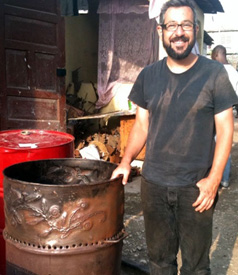Tiny group has big impact on spill estimates
SkyTruth, with one paid staffer and a one-room office, has caused officials to backtrack and revise what they say about the size of the gulf disaster.
An oil boom stretches across an opening in Lake Eloie near Shell Beach, La. (Gerald Herbert, Associated Press / April 23, 2010)
A tiny nonprofit group with one paid staffer in a one-room office in a small West Virginia town has been causing U.S. officials and oil company executives to backtrack and revise their estimates of the size and flow of the oil spill in the Gulf of Mexico.SkyTruth first analyzed satellite and radar data on the spill shortly after the Deepwater Horizon drilling rig sank after a fire April 22. It challenged initial estimates that 1,000 barrels of oil were gushing daily from the wellhead nearly a mile below the surface of the Gulf of Mexico, about 130 miles southeast of New Orleans. Federal officials and BP quickly revised the estimated daily rate to 5,000 barrels.
Saturday, the group updated its analysis to estimate that the slick contained more than 11.1 million gallons of oil, which would make it the largest oil spill in American history. John Amos, the group's president, also revised the estimate of the rate of oil leaking to 25,000 barrels a day, saying it was a "rock bottom" figure. There are 42 gallons in a barrel of oil.
Oceanographer Ian MacDonald of Florida State University had a slightly smaller estimate, saying on Saturday that the spill was 10 million gallons of crude oil.
The Coast Guard said Saturday it was becoming too difficult to estimate the spill's size. "Any exact estimate is probably impossible at this time," Coast Guard Adm. Thad Allen said.Allen said it was fruitless to discuss the differences between estimates of spill rates. "Quite frankly, the continued leakage of anything for an extended period of time is going to cause an extraordinary amount of problems for us," he said.
SkyTruth's work has been a thorn in the side of industry and federal officials during previous spills, and its analysis of the extractive industry's environmental footprint has drawn the wrath of mining and petroleum production companies.
Amos and SkyTruth volunteers work from computers, downloading digital imagery from satellites operated by NASA and private companies.
"Anybody can browse the Web and see the pictures; we want to get the underlying satellite image and bring it into our system at SkyTruth," he said. "We map-rectify it so it can be used to accurately measure and locate things, like the location of fisheries, wildlife refuges or other sensitive areas that could be impacted by this event."
In the case of estimating the amount of oil in the gulf's slick, Amos said it's simple to use the maps to calculate the depth of oil and its spread: The National Oceanic and Atmospheric Administration has standard methods to extrapolate oil volume in oil spills.
Amos acknowledges being a "bit of an oil-tech geek," saying he admires the technological leaps the industry has employed as it has pushed to retrieve oil from more and more far-flung places.
But he springs into action when accidents happen "because we've also found that in these situations, often they happen in very remote locations," he said. "The information coming from other sources is difficult to verify and, unfortunately, has proven sometimes to be to be demonstrably inaccurate."
Times staff writer Nicole Santa Cruz contributed to this article from Los Angeles.
Copyright © 2010, The Los Angeles Times










 Dignidad Rebelde is a graphic arts collaboration between Oakland-based artist-activists Jesus Barraza and Melanie Cervantes. We believe that art can be an empowering reflection of community struggles, dreams and visions. Following principles of Xicanisma and Zapatismo, we create work that translates people’s stories into art that can be put back into the hands of the communities who inspire it.
Dignidad Rebelde is a graphic arts collaboration between Oakland-based artist-activists Jesus Barraza and Melanie Cervantes. We believe that art can be an empowering reflection of community struggles, dreams and visions. Following principles of Xicanisma and Zapatismo, we create work that translates people’s stories into art that can be put back into the hands of the communities who inspire it.